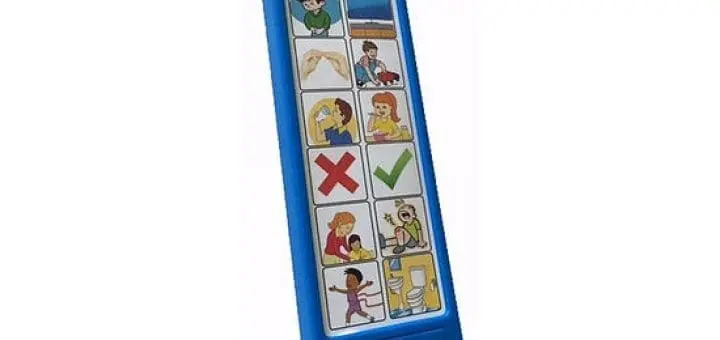A Simple Way to Help Your Child Communicate

Have you ever dealt with the frustration of not knowing what your child was trying to say? Do you have a child with communication delays or is nonverbal? Well, today! I’m excited to share with you about a simple speaking device that may just help!
The Tiny Talker – In a nutshell, it is a push-to-talk device that contains only 12 of the most basic/frequent words that a child might want to communicate: Yes, No, More, All done, Hungry, Thirsty, Help, Hurt, Play, Sorry, Television, Bathroom. It’s sold online for $15 plus tax and shipping.
Developed by parents for their non-verbal son
Inventor back story: Brittani and Ryan were high school sweethearts. After college, they got married, and both worked outside the home. He is a sales rep, and she is an attorney. In 2008, they had their first child, a daughter named Blair. In 2013, they had a son named Lucas. They started noticing Lucas was not hitting developmental milestones. After A LOT of doctor visits and two rounds of genetic testing, they finally got a diagnosis of Joubert Syndrome (a rare genetic disorder that causes a portion of the hindbrain to be under formed). Kids with Joubert Syndrome encounter problems with balance, coordination, speech, and eye movement. Some kids have more serious medical issues as well, but, this has not been the case with Lucas, so far.
Communication: Our son’s biggest issue
Lucas has been in therapy since he was four months old. He used a gate trainer for over a year, and this past summer, at 3 1/2 years of age, he started walking independently…which, as you might imagine, was a BIG deal in their house. Lucas lacks the fine motor skills for most sign language. His biggest issue is communication and his only word is “Hi.”
The therapists believe that he is cognitively “fairly normal” for his age (though it’s hard to tell since he is nonverbal). Because he has a good understanding of what is going on around him, he gets very frustrated when he can’t communicate what he wants, which can lead to behavioral issues. I can only imagine how frustrating it is for him when he can’t figure out what he wants, and it must be hard for everyone.
Ah ha, moment!
A few months ago we were having dinner at home, and Lucas was holding a small sound effect machine that Santa brought him for Christmas. My husband wondered aloud “Why doesn’t something like this exist as a speech device? Something small, basic, and expensive?” We “Googled” it, but, couldn’t find anything like what we wanted. We immediately started brainstorming what words should be on it and what it would be called. Shortly after that, my husband found a manufacturer to make them!
Our Thought process
We know that there are a lot of options on the market for speech, but we feel The Tiny Talker reaches a special niche. It is a great option because it’s portable, handy and has large enough buttons for kids with fine motor delays to manage. It also happens to be inexpensive enough to own more than one. I, personally, keep one in the cup holder of my car, beside my son’s car seat so that we can reach for it while in the car. We also have one in his backpack, one in his diaper bag, and one for his caregivers. Obviously, the device is limited because it only contains 12 words, but our thought process was that we want to keep the device as simple as possible. We also wanted to keep the price as low as possible so people could try The Tiny Talker as an option before they spend more money on more expensive devices. Case in point: about a year ago we bought Luke a $300 iPad app that he never uses!
This is a passion project for us; we are on a mission to find other special needs families that “The Tiny Talker” could help. (Fun fact: our daughter, Blair, is the voice on the device).
Expert Reviewer:
Kelly E. Walker M.S., BCBA gave it a “thumbs up.” Kelly said, “There are 12 main words, and these are words that kids are using. We would have to teach, or “train up” the users on some of these words and their related picture on the device….words like “help,” for example. Also, for example, the picture for the words “more, please” (fingers touching fingers) would have to be trained. But, this can be easily done, and this device can be VERY effective. Also, there are universal pictures, so I like that. It’s also very portable and seems like it could go anywhere. The parent would have to be ready to give more if they press more. If they want more candy, they would have to really be ready!
“The volume levels are good, and the parent can actually hear the commands. At a $15 price point, it seems pretty reasonable for the parent. Usually, these are way more expensive. I’ve seen some devices for $75 that provide only 2 or 3 words.
I’d give it a thumbs up, and YES, I would buy this. I’d like one or more to use with my clients”.
To purchase this product visit: The Tiny Talker
To learn more this product visit: The Tiny Talker.com
https://www.parentingspecialneeds.org/article/understanding-nonverbal-communication-to-better-connect-with-your-child/
Helpful Articles
- Understanding Nonverbal Communication to better connect with your child
- Communication and Connecting are Gifts to be Celebrated!
- ABOUT ME: Communication & Choice Making Guide
- Back to School Tip for Non-Verbal Children
- Independence and Self-Advocacy
- A Quality Conversation with My Nonverbal Son
- Listen Film Interprets Life Through the Eyes of a Non-Verbal Autistic Child
- Special Artisan and Crafter Lila Morrow
- Lifting Others: Kate Swenson
- Autistic Teen Finds Inner Voice
- Dad’s Emotional Video Defending Down Syndrome



